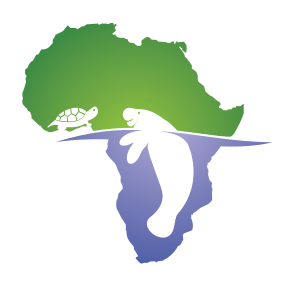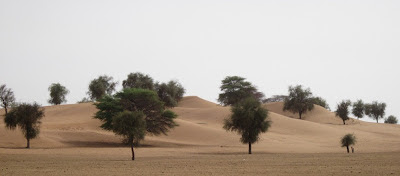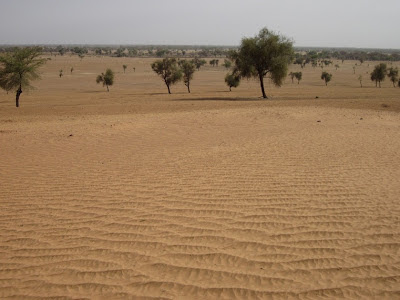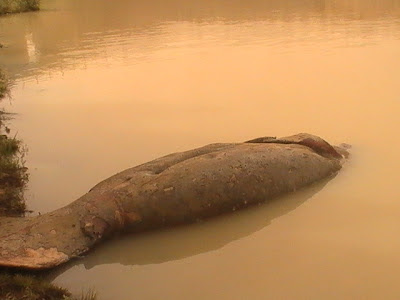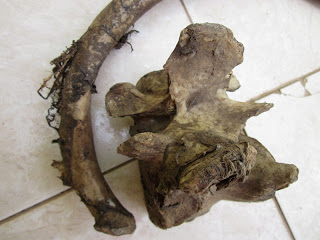It felt like getting to Matam was one of the hardest things I’ve done in a long time. After 3 weeks of endless car repairs, we were finally ready to try again to get to eastern Senegal for manatee fieldwork. Tomas and I left Dakar very early Tuesday morning, and it was exhilirating driving out of the city in the cool pre-dawn air. We had an easy trip to Richard-Toll, arriving there in mid-afternoon. After spending the night, we got up at 5:30am and had a quick cup of coffee before starting the long drive to Matam.
The road deteriorates quickly once you leave Richard-Toll, and eventually becomes a thin strip of asphalt riddled with deep potholes. When a car, bus or large truck is coming at you, it’s a constant game of chicken as both vehicles swerve around potholes and off the edge of the pavement to avoid hitting each other at the last second. There are also goats, sheep, donkeys, lots of cows, and the occasional camel standing in the road to avoid, and sometimes all traffic comes to a stop as a large herd crosses. Most of the time you drive on the dirt next to the road, rather than on it. Going too fast only results in flat tires, so you become resigned to a slow trip. This photo pretty much sums it up…
Along the way we stopped to climb some sand dunes that overlook the Senegal River in the distance. I have seen these dunes many times, but have never been able to stop before.
Below is a view of the Senegal River (the green strip on the horizon) from atop the dunes. In the rainy season the river floods this entire area, right up to the base of the dunes. In some places here, the river floods an area 30 miles wide. But the rains haven’t started yet, so everything in dry as a bone. Every time I make this trip, I find myself in a state of disbelief that manatees live in this harsh environment.
We reached Ourosougi, the town next to Matam, in the early afternoon and checked in at the Oasis Hotel. The Oasis is dusty, but it’s one of the only places in town with air-conditioned rooms, and with the thermometer at 112 F, it’s a necessity. In the evening we had dinner with our friend Commandante Seck, who used to work for ther Senegal River Authority (he was a great help in providing the tractor during our manatee rescues here in 2009) and now works for the Water and Forestry Dept. Although both water and forests are in short supply here, they’re in charge of wildlife issues and very interested in manatees. He invited us to his office to meet his new boss, so this morning we headed over there.
We had a really nice meeting with Commandante Seck and Mr. Dieng, who it turned out Tomas knew from his days reintroducing sulcata tortoises to the wild in the Ferlo, in central Senegal. We explained our history working with manatees in this area, my interest in developing a long-term study site here, and that our current mission is to collect samples of foods that manatees eat (plants, fish, and freshwater mollusks), as well as any recent information about manatees here. They immediately told us that there had been two dead manatees: one last August 2011 in Kanel (about an hour south) and one at the nearby Navel Dam last February.
Navel is a tributary of the Senegal River, and the Navel Dam has been a problem for manatees ever since it’s construction was completed in 2007. Several have drowned up against its grates or have been crushed by the gates as they closed. Mr. Dieng gave me copies of the photos and measurements they took (unfortunately no one did a necropsy) before they buried it. From the photos it appears this manatee starved to death, which is not surprising, because there are no plants for them to eat once the water recedes back to the channel. Although it’s fairly decomposed in the photo below, the longitudinal fold in the manatee’s belly indicates it was emaciated (other photos show additional signs). This is another unfortunate consequence of the dam- manatees get trapped and can’t leave as the waters recede and all their food sources die off during the dry season. Before the dam they followed the receding water back to the Senegal River, but now the dam traps them in this tributary.
Photo courtesy of Senegal Water and Forestry Department
There was no report or photos of the second dead manatee at Kanel, but a few bones had been collected, and Mr. Dieng allowed me to take two for my analyses in Florida. These bones had dried tissue on them which will be good for genetics analysis, and a sample of the bones will be used for stable isotope analysis to determine the manatee’s diet. Tomorrow we’ll drive to Kanel to try to find the rest of the carcass and sample manatee food items there as well.
In the evening we drove out to Navel, looked at the dam and walked around part of the tributary where we rescued 7 manatees in 2009. It was peaceful although still brutally hot, even as the sun set. I saw a farmer working at the edge of the river and stopped to say hello. We chatted for awhile and then I mentioned I was interested in manatees. He told me he had seen one there in the tributary yesterday, laying on the surface at noon. He told me he had thrown a corn stalk to it, and the manatee had immediately eaten it. He also said they eat tomatoes and other plants at the water’s edge. I’m disheartened to hear there is another manatee (and maybe more than one) trapped here, because the tribuatry is miles long, muddy and deep, so it would be almost impossible to catch it now. Sometimes people tell you what they think you want to hear, so I’d like to confirm this man’s story and will definitely let the Water and Forestry guys know about it.

